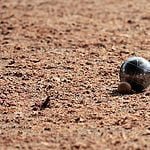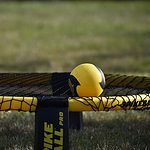Imagine bocce ball as a strategic dance on a sunlit court, where every move counts towards victory. As you navigate the intricacies of this timeless game, you'll uncover the nuances that separate the amateurs from the champions.
From mastering the art of the perfect throw to understanding the subtle tactics that can turn the tide in your favor, there's a world of possibilities waiting to be explored.
So, grab your bocce set and get ready to unlock the secrets that will elevate your gameplay to new heights.
Key Takeaways
- Understand basic rules, setup, and gameplay techniques for successful bocce ball play.
- Learn scoring methods and variations to enhance competitiveness and enjoyment of the game.
- Explore equipment options, where to play, and advanced strategies for strategic gameplay.
- Master throwing techniques, defensive plays, and teamwork for a well-rounded bocce ball experience.
Overview of Bocce Ball Rules
When learning the rules of bocce ball, it's essential to understand the basic principles that govern this popular game. Bocce ball is typically played with two teams, each consisting of one, two, or four players. The objective is to get your team's bocce balls as close to the pallino as possible while outmaneuvering your opponents.
Each team has four bocce balls, usually divided into two colors to differentiate between the teams. The small white pallino serves as the target ball, and players must aim to have their bocce balls closer to it than the opposing team's closest ball. Remember, staying behind the designated foul line when throwing your bocce balls is crucial to avoid fouls.
Scoring in bocce ball is based on the number of bocce balls from each team that are closer to the pallino. Any balls that are out of bounds are considered dead for that frame and aren't counted towards the score. To fully enjoy the game, familiarize yourself with the specific rules and regulations, as they can vary depending on the setting.
Setting Up the Bocce Court
To set up the bocce court properly, begin by ensuring the playing surface is flat and measures ideally 76 feet in length by 12 feet in width for official matches. Mark the court with boundary lines and a center line to guide gameplay effectively. You can use chalk, string, or other markers to clearly define the court boundaries.
The boundary lines help players understand the limits of the playing area, while the center line assists in positioning the pallino accurately. Designate a specific spot on the court for throwing the pallino to initiate the game. Setting up the court correctly is crucial as it ensures fair play and an enjoyable experience for all participants.
Equipment Needed for Bocce Ball
After setting up the bocce court properly, the next step is to gather the necessary equipment for the game. The key essentials for playing bocce ball are the balls and the pallino. A standard bocce ball set typically includes 8 colored balls and 1 smaller white pallino. The regulation-sized bocce balls have a diameter of 107 mm and weigh 920 g each. Professional-grade resin sets are also available for purchase, offering durability and precision in gameplay. When acquiring a bocce ball set, be prepared to spend at least $20 for a standard set, with professional sets exceeding $100 in cost. Bocce balls can be used for solo play or in teams of 2, 3, or 4 players, making it a versatile game for various group sizes.
| Equipment | Description |
|---|---|
| Bocce Balls | Come in a set of 8 colored balls |
| Pallino | 1 smaller white target ball |
| Regulation Size | Diameter of 107 mm, weight of 920 g per ball |
| Professional Sets | Available for purchase, offering enhanced quality |
How to Play Bocce Ball
Begin your game of Bocce Ball by setting up the court according to the designated measurements and marking the boundaries clearly. The game is played in frames until a team reaches a pre-determined score, usually 12 points. Two teams, each with one, two, or four players, take turns throwing four balls per frame. The objective is to get your bocce balls closest to the Pallino to score points and win frames.
Key Points:
- Play in teams, with each team taking turns to throw four balls per frame.
- The team that gets their bocce closest to the Pallino wins the frame and scores points.
- Aim to strategically position your bocce balls closest to the Pallino to outscore the opposing team.
Techniques for Throwing Bocce Balls
When mastering techniques for throwing bocce balls, focus on perfecting your grip and release to enhance accuracy and control. The underhand throw is the standard technique used in bocce ball, where players often aim just in front of the target area to achieve desired results. Gripping the ball with the palm underneath or above can impact the trajectory of the throw. There are two common throwing styles in bocce ball: high, soft lobs for precision and low, strong throws for power. Experimenting with these different throwing styles can help players find their optimal technique.
| Throwing Techniques | Description |
|---|---|
| Underhand Throw | Standard technique in bocce ball. Aim just in front of the target area. |
| Gripping the Ball | Palm position (underneath or above) can affect the trajectory. |
| Throwing Styles | High, soft lobs for precision. Low, strong throws for power. |
| Experimentation | Try different styles to find your optimal technique. |
Understanding Bocce Ball Scoring
To understand Bocce Ball scoring, focus on how points are awarded based on ball proximity to the pallino. Points are allocated based on the number of balls closer to the pallino than the opponent's closest ball.
Here's a breakdown to help you grasp the scoring system:
- Closest Ball Rule: In Bocce Ball, only the team with the closest ball to the pallino scores points. If your team has the two closest balls, you earn two points.
- One Point Per Ball: For each ball your team has that's closer to the pallino than the closest ball of your opponent, you score one point.
- Measuring Distance: Accurate scoring requires measuring the distance between the balls and the pallino. A tape measure or designated markers are commonly used for this purpose.
Understanding these fundamental scoring principles will help you track points accurately and strategize effectively during a Bocce Ball game.
Strategies for Winning Bocce Ball
Now, to enhance your chances of winning at Bocce Ball, focus on employing strategic maneuvers that involve positioning your balls strategically on the court. To score points effectively, aim to place your bocce balls closest to the pallino. This not only increases your scoring potential but also makes it challenging for your opponents to surpass your position.
Utilize strategic blocking by strategically placing balls in front of the pallino to obstruct your opponents' path. Targeting your opponents' balls to move them away from the pallino can improve your chances of scoring and disrupt their game plan.
Adapt your throwing technique based on the pallino's position and the placement of your opponents' balls. By analyzing the court and planning your throws carefully, you can optimize your strategy and increase your likelihood of winning.
Common Bocce Ball Fouls to Avoid
One of the most crucial aspects of playing Bocce Ball is understanding and avoiding common fouls that can impact the game's outcome. To ensure fair play and maintain the integrity of the game, it's essential to steer clear of the following fouls:
- Stepping over the foul line during a throw results in a foul, potentially affecting the accuracy of your shot and giving your opponents an advantage.
- Moving the Pallino while attempting to measure distances is considered a foul, as it can alter the position of the target and disrupt the game's flow.
- Intentionally moving opponent's balls during measurement is a foul in bocce ball, as it goes against the spirit of friendly competition and fair play.
Different Variations of Bocce Ball
Different variations of Bocce Ball offer unique rules and gameplay strategies for players to enjoy. Classic Bocce is the traditional version where the objective is to roll your ball closest to the pallino. This variation focuses on precision and accuracy, requiring players to carefully aim their shots.
Open Bocce, on the other hand, introduces a more aggressive element by allowing players to hit and displace their opponent's balls. This strategic twist adds an exciting dynamic to the game, as players mustn't only focus on their own shots but also on disrupting their opponent's placements.
Volo Bocce is a faster-paced alternative where players throw their balls in the air instead of rolling them along the ground. This variation requires a different technique and skill set, as players need to adjust their throwing strength and angle to land their balls close to the target.
Each variation of Bocce Ball has its distinct set of rules and challenges, providing players with a range of options to suit their preferences and playing styles.
Where to Play Bocce Ball
For the best Bocce Ball experience, consider playing on surfaces like grass, sand, or designated courts. When deciding where to play Bocce Ball, keep in mind the following options:
- Backyard Bocce: Setting up a game in your backyard is a convenient and fun way to enjoy Bocce Ball with friends and family. You can easily create boundaries on a leveled lawn to mimic a Bocce Ball court and start playing right away.
- Beach Bocce: Playing Bocce Ball at the beach adds a unique twist to the game. The soft sand provides a different challenge and an extra element of fun to your gameplay. Just mark your playing area and enjoy a game under the sun while feeling the sand between your toes.
- Official Bocce Ball Courts: If you're looking for a more structured environment, consider playing on official Bocce Ball courts. These courts are regulation size, measuring 76 feet long and 12 feet wide, providing an authentic Bocce Ball experience.





